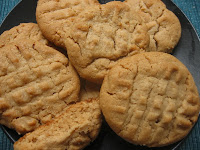Last week's
wingin'-it loaf yielded a great slice: light, moist, and springy, with a nice crunch from the cracked wheat. With only 1/2 cup cracked wheat vs 1-1/2 cups multigrain cereal, it's a little less dense than the original recipe, and has a less complex flavor. Still, it's a good starting point for cereal/wheat/white ratio experiments. Delightfully chewy and with a decent wheatiness, it's easily good enough to stand on its own, too. And, it makes great toast.
To start, combine 1/2 cup cracked wheat
1-1/2 cups cups boiling water
Cook about 10 minutes, till most of the water is absorbed. Mine didn't and it was fine. In fact, I was glad, because I wanted that water to be soaked up by a little 8-grain cereal. Also, be warned: the slurry will want to
boil over.
When it's done cooking, pour into the bowl of a standing mixer or other large bowl.
Stir in the last of your
multigrain cereal (I used about
1/4 cup)
Let stand for 10-15 minutes.
Add
1/4 cup butter and stir till it's mostly melted
Cook's calls for 2-1/2 cups water; Beard, 2-1/2 cups (milk/water) + 1/3 cup water in which the yeast is dissolved. I don't much care about that 1/3 cup, so I add
1 cup lukewarm water (actually, about half water and half skim milk, because it's hard for me to finish a carton.)
Before proceeding, check the mixture's temperature - you don't want to kill the yeast. It should be about 100
°.
Stir in
2 Tbsp honey
2-1/2 tsp instant yeast
Then, work in gradually
8 oz whole wheat flour (about 1-1/2 cups)
14 oz white flour (2-1/2 -- 3 cups; I used a mix of high-protein and all-purpose)*
Add about 1 cup of flour at a time or you will have a Big Floury Mess.
(I didn't forget the salt; it's added later)
Knead with the stand mixer (or by hand - it's fun! Try it!) till it forms a pleasing ball. This should take a couple of minutes. Cover with a tea towel and let stand for 20 minutes.
Add
2-1/2 tsp salt
1/4 cup flax seeds
1/2 cup rolled oats
Knead in as best you can. My mixer does a terrible job of both incorporating the flour at the bowl's bottom and distributing the oats and seeds, so at this point, I knead by hand for a few minutes. I also like feeling the dough come to life in my hands.
Put back in the bowl, cover, and let rise for 45-90 minutes, till doubled in bulk. (Confession: I put the dough right back into the unwashed, ungreased mixing bowl. With 1/4 cup butter and a quick rise, it's fine. Really.)
When the dough's doubled, punch it down and let rest for 10 minutes. The rest period makes it easier to shape, though frankly, my attitude toward shaping mirrors my attitude toward placing the dough into a pristine, greased bowl. I like my loaves to look nice; I do not require perfection. Divide the dough in half (I may not shape but I do weigh), shape into loaves, cover, and let rise till the dough is peeping over the rim. At this point, I wet one hand, give each loaf top a good rubdown, and sprinkle well with quick oats. (I find that quick oats adhere better than regular rolled oats)
Bake at
375 degrees for
35-40 minutes, until the bread registers 200 degrees.
Tip out of the pans and let cool.
I slice and freeze what I don't eat immediately, then pull out slices as needed.
*The measurement for white flour is approximate and will depend on whether you use a mix of bread/all-purpose or either one singly. You'll probably need more than 14 oz flour if you're using only all-purpose, and less than 14 oz if you opt for bread flour. Weather conditions, accuracy of measuring utensils, and other factors will have a bearing on how much flour is needed.
Experiment! Don't be afraid! It's bread, and forgiving. It
wants to be baked.













































